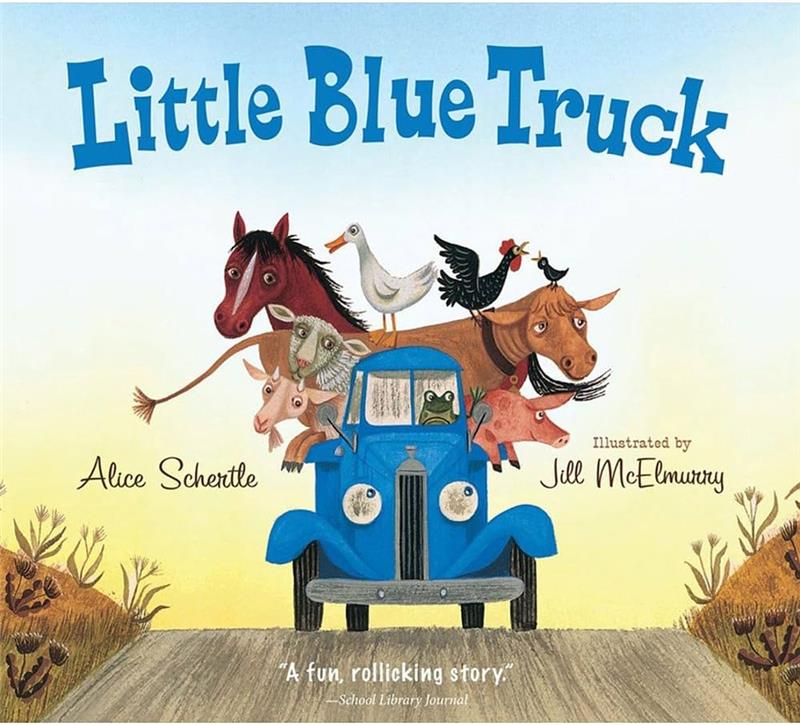This month's Book Nook topic is...
Building Sound Awareness with Little Blue Truck

Helping children understand that words can be broken down into individual sounds is called sound awareness or “phonological awareness”. This is an essential skill that leads to better reading and writing later on.
One of the first signs that your child is developing sound awareness is his recognition of rhymes – for example, knowing that the words “night” and “fight” sound the same at the end. You can use a strategy called “Listen… and Find One Like It” to help your child tune in to words that start (alliteration) or end (rhyme) with the same sound.
Let’s get started!
The Book:
Little Blue Truck by Alice Schertle, illustrated by Jill McElmurry
Why we chose it
Little Blue Truck is about a friendly blue truck who teaches a big dump truck about the importance of being kind. The entire story is told in rhyme, which makes it a great fit for the “Listen… and Find One Like It” strategy.
Listen… and Find One Like It
The strategy works exactly how it sounds.
Step 1 – Listen
When reading (or singing) with your child, point out rhyming words. If you’re reading Little Blue Truck, you could say: “Listen, ‘truck’ and ‘stuck’ rhyme – they sound the same at the end. Listen. ‘Truck’. ‘Stuck’.”
Step 2 – Find One Like It
Have your child help you find another rhyming word. You could say: “Let’s think of another word that sounds like ‘truck’ and ‘stuck’. How about ‘muck’? ‘Muck’ sounds like ‘truck’ and ‘stuck’. ‘Muck,’ ‘truck’ and ‘stuck’ all rhyme. They all sound the same at the end of the word.”
It’s fine if your child can’t yet produce a rhyme – we wouldn’t expect him to catch on right away! Exposing your child to the idea of rhyming words will build his sound awareness. Offer many of your own examples of rhyming words before expecting him to come up with his own the first time you introduce the “Listen… and Find One Like It” game.
The first time you read the book
During the first read, you can emphasize the words that rhyme (there are rhyming words on every page of the book).
For example, on the first page you could say:
“Horn went ‘Beep!’
Engine purred.
Friendliest sounds
you ever heard.”
As you read, you can pause before the second rhyming word (“heard” in this example) to see if your child wants to try to fill in the missing word.
The second time you read the book
Now that you’ve been through the book once, you can be more explicit about the rhyming words. You can read a page, and say, “Listen. ‘Road’ sounds like ‘toad’. ‘Road’ and ‘toad’ rhyme. Say the words with me. ‘Road’. ‘Toad’. Do you hear how they sound the same at the end of the word? ‘Road’. ‘Toad.’”
After your child repeats the words once or twice, say: “Let’s think of another word that rhymes with ‘road’ and ‘toad’. How about ‘load’? ‘Load’ sounds like ‘road’ and ‘toad’. ‘Load,’ ‘road,’ and ‘toad’ all rhyme. They all sound the same at the end of the word.” You can do this on almost every page of the book – and many children find this to be a fun activity!
The third time you read the book
You can point out other rhymes that you may not have pointed out during the second reading – since there are rhymes on every page it would be difficult to highlight them all in one shot! During the third reading, you could emphasize “peep” and “beep.” Point out that they rhyme in the same way as you did for ‘road’ and ‘toad’.
Since your child has now heard many rhyming examples for the “find one like it” part of the strategy, you can ask him to come up with a word. You can say “Can you think of another word that rhymes with ‘peep’ and ‘beep’?” Then wait to see if he attempts to fill in a word. If you wait (for five to ten seconds) and your child doesn’t respond, then you can help him by saying “What about ‘sleep’?”. “’Sleep,’ ‘peep’, and ‘beep’ all sound the same at the end – they all rhyme.”
This strategy can be a lot of fun and can get silly quite quickly – as children will tend to make up nonsense words when they can’t think of a real word that rhymes. After a while, try to get your child to find rhymes in other books and songs that you enjoy together.
Taking “Listen… and Find One Like It” outside of book reading
If your child likes this game, you can play it throughout the day – it does not need to be confined to book reading. Whether you are eating breakfast or are out on a walk, you can play “listen…and find one like it”.
For example, while on a walk, your child might notice a cat. You could say, “Listen, ‘cat’ rhymes with the word ‘hat’. ‘Cat.’ ‘Hat.’ They sound the same at the end of the word. ‘Cat’. ‘Hat’. Can you think of another word that rhymes with ‘cat’ and ‘hat’?” If your child comes up with a rhyming word, that’s great! If not, you can suggest one for him (“What about ‘bat’? ‘Bat,’ ‘cat,’ and ‘hat’ all sound the same at the end. They all rhyme.”)
Happy reading and rhyming!
More Resources
The strategies in this Book Nook post are drawn from Hanen’s practical, research-based guidebooks for building emergent literacy. Explore the links below to learn more about how these guidebooks can support you.
For Parents I'm Ready! guidebook
I'm Ready! guidebook
For Educators ABC and Beyond guidebook
ABC and Beyond guidebook
